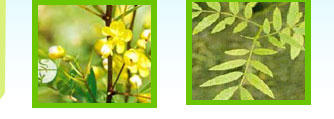Senna is the
most widely used anthranoid drug today and has been used fro centuries
in Western and Eastern systems of medicicne as a laxative, usually
taken as a tea or swallowed in powered form. Its medical use was
first described in the writtings of Arbian physicians Serapion
and Mesue as early as the 9th century A.D. The name Senna itself
is Arbian.
Besides its wide use in conventional Western medicine, Senna leaf
remains an important drug used in traditional Chinese medicine
and traditional Indian Ayurvedic and Unani medicne.
Medicinal Parts used : Dried fruit pods and leaves (Dried leaflets),
the leaf tend to be used in making tablets, the fruit (pods) is
most commonly used for preparation of Senna infusion (tea), Scientifically,
the pods are crushed and made into tablets.
Historical or Traditional use (may or may not be supported by
scientific studies) : People in northern africa and Southwestern
Asia have used Senna as a laxative for centuries. It was considered
a "cleansing" herb because of its cathartic effect.
In addition, the leaves were sometimes made into a paste and applied
to various skin diseases. ringworm and acne were both treated
in this way.
Constituents of Cassia Senna :
Anthraquinone Glycosides : In the leaf, sennosides A and B based
on the aglycones sennidin A & B, Sennosides C & D which
are glycosides of heterodianthrones of aloe-emodin and rhein.
Others include palmidin A, rhein anthrone & aloe-emodin glycosides,
some free anthraquinones and some potent, novel compounds of as
yet undetermined structure. C. Senna usually contains more of
the Sennosides.
Anthraquinone Glycosides : In the fruit, Sennosides A and B and
a closely related glycoside Sennoside A!.
Naphthalene Glycosides, tinnevellin glycoside & 6-hydroxmusizinglycoside
Miscellaneous, mucilage, flavonoids, volatile oil, sugars, resins
etc.
Main effective constituents : Sennosides C, Sennosides D, Rhein,
Chrysophanol, aloe-acid, isorhamnetin, barbaloin, kaempferol etc.
Senna leaf contains 1.5-3% hydroxyanthracene glycosides, mainly
Sennosides A and B, which are rhein-dianthrones and smaller amounts
of Sennosides C and D, which are rhein-aloe-emodin-heterodianthrones,
naphthalene glycosides, flavonoids (derivatives of kaempferol
and isorhamnetin), 10-12% mineral matter, 7-10% musilage (galactose,
arabinose, rhamnose and galacturonic acid), about 8% polyol (pinitol),
sugars (glucose, fructose and sucrose) and resins.
Also Visit : www.berberine.co.in,
www.hindphrm.com,
www.
belladonna.co.in




